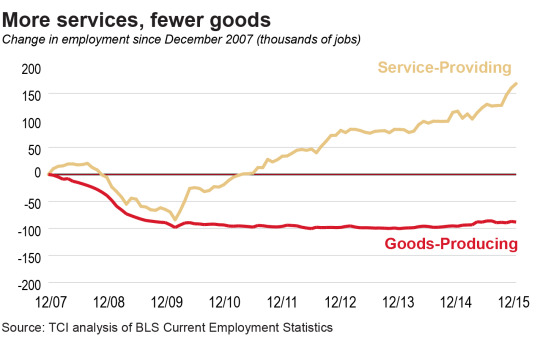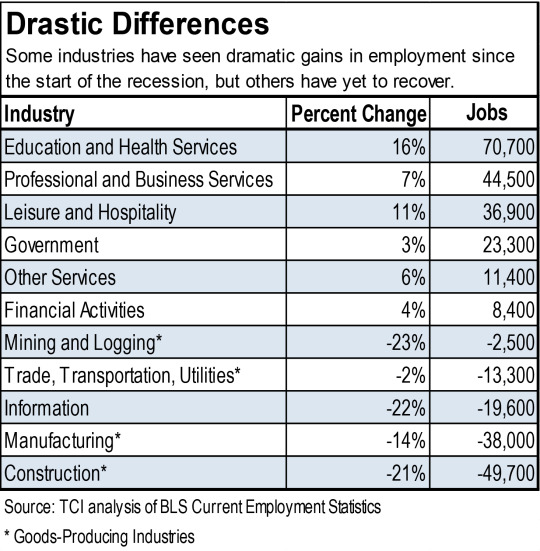February 10, 2016
Looking Out for Those Left Behind in the New Virginia Economy
December marked the eighth anniversary of the official beginning of the Great Recession, and while Virginia wasn’t hit as hard as some other states, many working people here still feel the damage of the financial crisis and the tough times that followed.
Virginia has made lots of progress recovering from the recession – mostly in Northern Virginia, which has added about 85,000 jobs since before the recession. The rest of Virginia is still about 14,000 jobs short of where it was before December 2007.
There are more people in Virginia now than there were eight years ago. From 2007 to 2015, Northern Virginia added about 370,000 residents and the rest of the state added about 260,000. This means job gains even in Northern Virginia haven’t kept pace with population growth, and in the rest of Virginia it means some places have more people and fewer jobs.
Drill down into various industries and the disparities are even more dramatic. Service-providing work has more than erased any recession-era losses; employment in goods-producing industries like mining and logging, and manufacturing remains stubbornly low.

Service industries that often require some college education, such as education/health services, and professional/business services, have been the biggest drivers of job gains. Meanwhile, jobs in industries that have traditionally relied on on-the-job-training – construction, manufacturing, and trade/transportation/utilities – are sharply down.

Unfortunately, many of the reductions in goods-producing industries are likely to be here to stay. The increase in natural gas production caused by fracking in other states, for example, has sped the decline of coal mining employment in Virginia. The bursting of the housing bubble and under-investment in infrastructure have sidelined many construction workers. Automation and trade imbalances have decreased manufacturing employment. The persistent reduction in employment in these industries helps explain why many Virginians still struggle to find good-paying, full-time employment.
Many Virginians are out of work or stuck in low-wage jobs for reasons well beyond their control. They need a stronger state workforce development system that will give them the tools to succeed. Meanwhile, they also need support to help stay afloat. That means reasonable Temporary Assistance for Needy Families (TANF) cash assistance, a strengthened earned income tax credit (EITC), and health coverage. And to make sure Virginia’s workforce of the future is prepared to thrive in the new economy, workers will need to be better educated than ever before, from kindergartners to graduate students.
The growth in employment in Northern Virginia is a positive sign, but too many areas of the rest of the state still lack adequate opportunity. The increase in service-providing jobs is a welcome change after the recession, but too many Virginians who lost jobs during it are still stuck on the sidelines despite being eager to jump in.
Virginia must find a way to build on its strengths and focus on growing industries that can bring prosperity to their communities while also protecting families who are struggling – and making sure everyone who works hard can get ahead.
–Aaron Williams, Research Assistant
